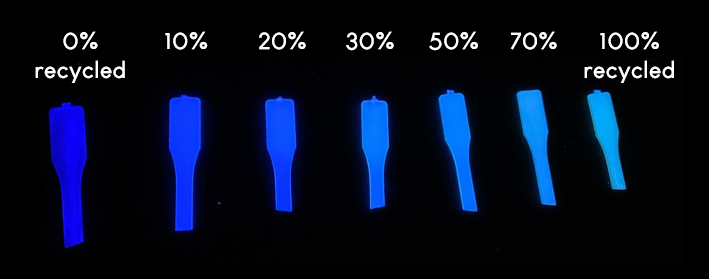Researchers from the Sustainable Materials Innovation Hub have developed a novel solution to identify the quantity of post-consumer recycled materials used in the production of plastics and part of the Recon2 project (Recycled Content Reconnaissance).
The group’s latest innovation utilises a fluorescent marker that can be added to raw polymer materials during standard recycling processes. Subsequent dilution of the marked recyclate induces a change in the concentration of the fluorescent marker and alters the material’s fluorescent behaviour. Measurements of modified fluorescent behaviour allows quantification of recycled content.

This unique fluorescent-based marking system removes the ambiguity from existing methods of post-consumer recycled quantification which are known to give ambiguous and incorrect results. The technology also has no detrimental effect on plastic properties and works for both mechanically and chemically recycled wastes.
The project is led by 2nd year PhD student Zoe Schyns who discovered the unique properties of the fluorescent marking system. Commenting on the project Zoe said:
When we first trialled the marker in recycled plastics, we were astounded by the results. There are no other methods of quantification that allow for such accuracy whilst still maintaining the quality of recycled plastics. The applications of the technology are really exciting and we’re trialling its use on a variety of plastics with very positive results.
The UK’s plastics packaging tax will come into force from April 2022 and will impose a £200/tonne tax on any plastic packaging that incorporates less than 30% recycled content. This latest innovation opens up a host of opportunities to support the implementation of the tax, including the development of a tool for industry to demonstrate the quality of recycled materials in their packaging.
The research group now have a patent in place for the fluorescent marking system and continue to trial its use on a variety of plastics including HDPE, PET and PP. The UK’s plastics tax is likely to set a global precedent, leading to the need for a robust tool to help governments ensure compliance with any future recycled materials requirements. These may be early days for the Recon2 project but there are boundless opportunities to help deliver a more sustainable future.
Accelerating innovation in Greater Manchester housing
Sustainability Workshop for Art Packaging
Hear about the latest news, opinions and activities from the SMI Hub